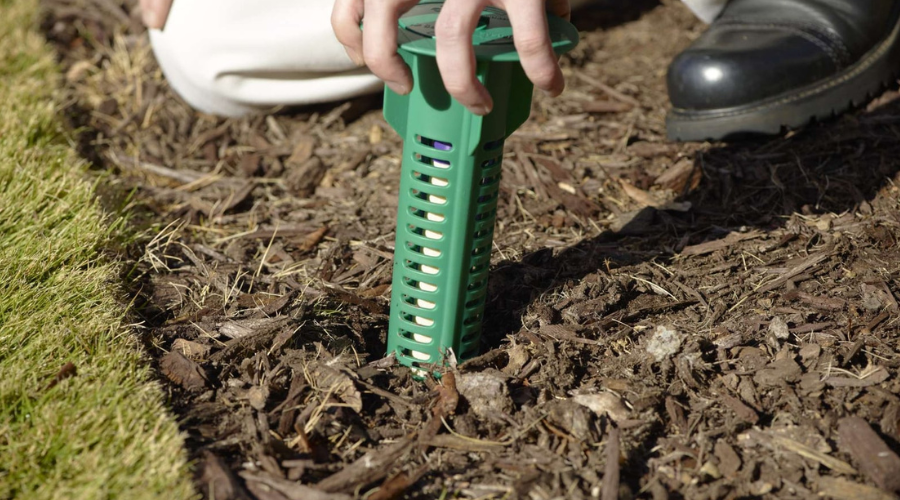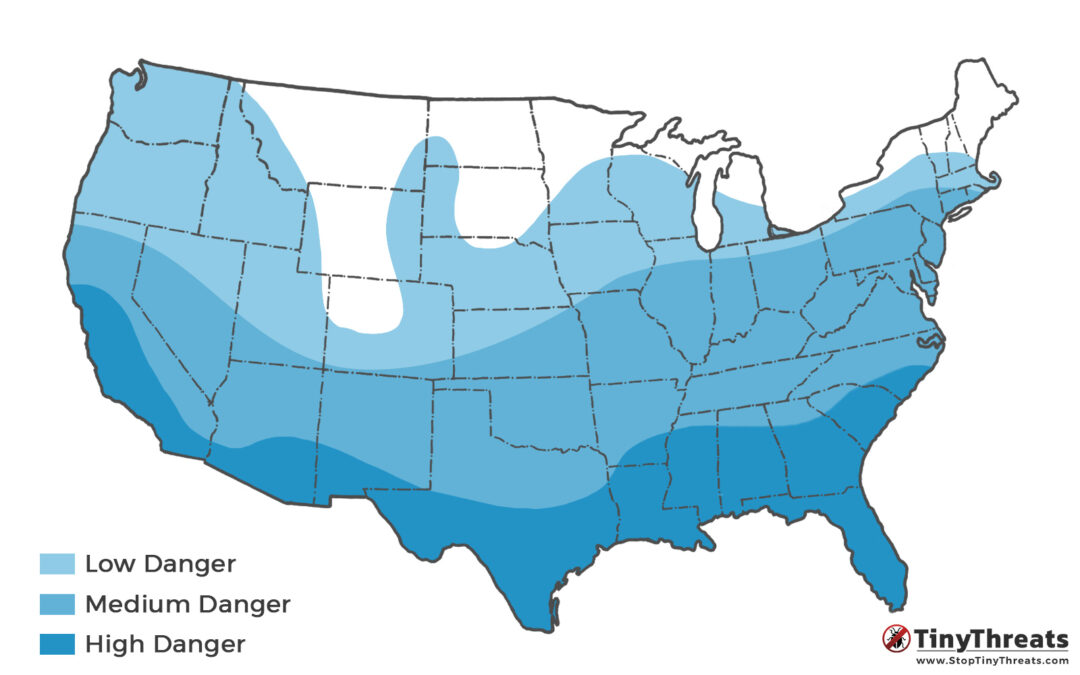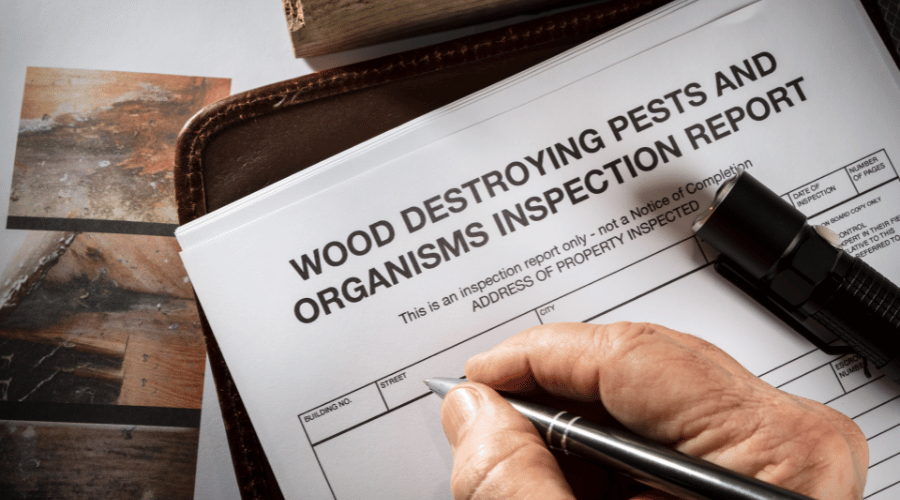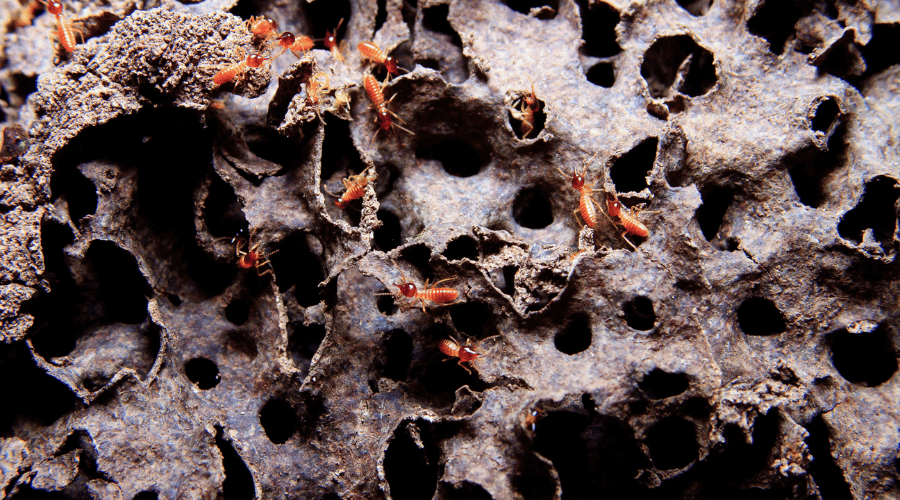Termite bait traps, also known as termite bait stations, are one of the most effective treatment and prevention methods against subterranean termites below and around your house.
Termite bait traps work by attracting them with poisoned food – the termites eat some and bring the rest back, poisoning the rest of the colony and slowly wiping it out.
The exact effects depend on the chemicals used, but the key feature of these traps is that they don’t only kill the workers that find them, but aim to kill the queen of the colony or prevent reproduction in other ways.
This way, termite bait stations can actually stop the entire colony, rather than just killing off a few workers.
Table of Contents
What are Termite Bait Traps?
Termite bait traps are named very clearly – they are traps that you bury around your home, containing bait that attracts and poisons termites.
Since they are submerged into the soil, they are made specifically for subterranean termites.
Since drywood and dampwood termites don’t run around much outside of their colony in the wood of walls they infest, traps would not work well for them.
Termite bait stations are also often used in combination with chemical soil treatment, as both are aimed at preventing subterranean termite intrusions.
Recommended read: Our guide to Pre-Construction Treatment for Termites.
One big reason why these traps are so popular is that they are passive and simple to install. You don’t need to locate the colony first, which can be very difficult for subterranean termites. You simply let them find the trap, doing all the hard work, and essentially exterminating themselves.
Another advantage is that they can be installed anytime. Other protective methods like termite shields can only be installed during home construction.
How Termite Bait Stations work
Termite bait stations contain two things: The bait and the poison.
Usually, the bait is a simple food source – pieces of wood that termites like.
But the bait is also treated with the poison, so when the termites bring home the food they found, they bring back the deadly chemical.
Since the workers are responsible for feeding the colony, they bring that food to those that need it: The queen and king, secondary reproductives, any internal workers that only care for the reproductives, and soldiers. The food will also reach the termite larvae (baby termites).
Once the poisoned food reaches the colony, it starts wreaking havoc in various ways. While it may take months for a termite bait system to wipe out a colony, it can be more thorough than most other treatments in doing so.
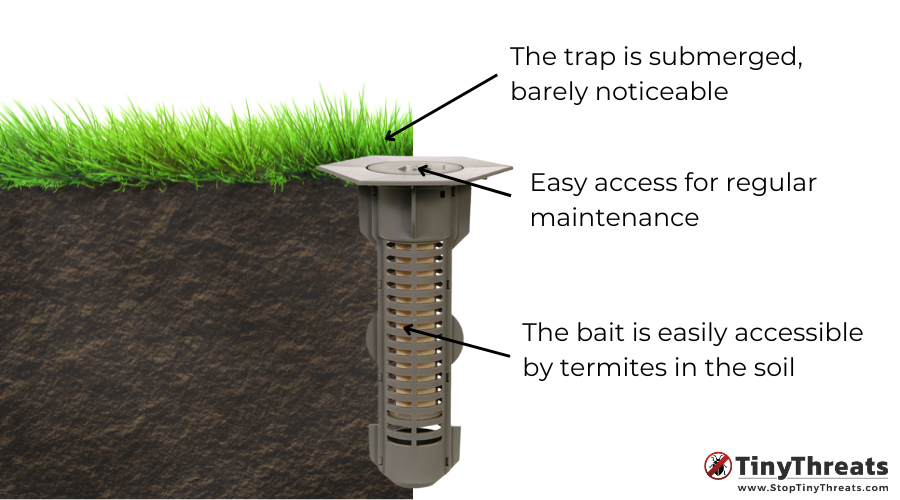
Termite Bait Stations – Monitoring vs Baiting
One more important distinction is between an “active” termite bait trap, and a monitoring trap.
At first, many exterminators install only monitoring traps. These do not contain any chemicals, only food (usually wood or compressed cellulose material). However, by looking at how much food was taken by termites, the exterminator can estimate the size of the colony.
Also, you might have these traps installed for months or years with no activity at all if you have no active colony near your house.
That’s why many bait systems are set up as monitoring stations first – to observe termite activity, and only start acting once activity has been confirmed.
Then, once termites are active, the poisoned food is added to the bait traps.
Types of poison used in termite bait traps
Hexaflumuron is one common poison for two simple reasons: It contains cellulose, the main food source of termites. This makes the poison itself attractive to termites – a dangerous combination for them.
Once a termite ingests Hexaflumuron, the chemical slowly destroys the insect’s exoskeleton and mandibles, leading to its death. Since it works slowly, it gives the termite enough time to carry the poison back to the colony, so it can kill more important members of the colony, like the queen or king.
In one study, just three bait tubes with Hexaflumuron were able to wipe out a colony of over 150,000 termites within only one month – though this is faster than usual, it shows just how powerful such a trap can be.
Another type of poison are Insect Growth Regulators (IGR) such as Chitin Synthesis Inhibitors (CSI). These are also aptly named: These poisons prevent proper growth of insects by preventing them from molting. Molting is when an insect sheds their exoskeleton/skin to grow into a bigger one, like you may know snakes to do.
In one study, though on mosquitoes, a Chitin Synthesis Inhibitor, triflumuron, was not only able to prevent 100% of effected insects from maturing, but also showed no effect of any common resistances. This means that unlike traditional pesticides, insects might be unable to develop resistance against such substances – which is very important for long-term effectiveness of such pest-control methods.
How bait systems are installed and monitored
Usually, termite bait stations are installed by an exterminator as part of a long-term contract. After analyzing your home environment (soil, weather,…), the exterminator will install the bait traps in strategic locations.
Then, they will need to check in and monitor the traps on a regular schedule. Depending on your area and the termite risk, this can be anything from monthly check-ups to once-a-year visits.
During these visits, the exterminator can determine if there is any termite activity around your house, and how to proceed if there is.
To make sure these traps work properly, use the right chemicals, and wipe out the full colony, termite bait stations are best installed and maintained by a professional.
While it may be tempting to order traps online and install them yourself to save money, it may end up costing you much more if your DIY system does not successfully prevent termites from invading your home.
When to use a Termite Bait Trap
Termite bait traps are very effective against subterranean species, so if you live in an area that is plagued by these species, bait systems are a good choice – even if you’ve never had termites yet.
These traps are not only to combat active infestations, but mainly as precaution to monitor and prevent termites from invading your home.
One big advantage they have over liquid soil treatment is that these traps, while untouched by termites, do not affect the environment at all. There are no chemicals given off into the soil, the ground below, or even to plants or groundwater.
In some areas, these eco-friendly benefits are not just benefits, but requirements. Soil treatment might simply not be legal in your area, which is another reason why bait systems may be chosen.
Unlike most termite treatments, bait stations also allow you (or your local professional) to monitor their activity so you know that termites are active as soon as possible. Many other termite control methods don’t offer that advantage.
The downside to bait stations is the regular maintenance – soil treatments are “set-and-forget”, while bait stations need regular visits by the pest-control company.
How much do termite bait stations cost?
Since termite bait stations are placed around your house based on your specific situation, the cost can vary greatly. Some companies estimate as little as $300-$500 for the setup of termite bait systems, while others expect them to cost $2,000 and more.
According to Homeguide.com, you can expect to pay around $6-10 per linear foot. Linear foot describes the circumference of your house in this case. Since the traps are placed like a barrier around your house, the length of this barrier determines the number of stations, and thus the price.
Additionally, you can expect to pay around $300 for yearly monitoring. Again, highly dependent on the size of your house/property, and on the frequency of visits.
Common Questions
How long do termite bait stations last?
Termite bait stations can last up to ten years, but should be checked regularly for activity. Check-ups can be anywhere from monthly to yearly, depending on your location and termite risk.
Are termite bait traps safe?
Termite bait traps are 100% safe, as they are hidden beneath the ground and do not give off any toxins or dangerous chemicals. The poison is only accessed by the termites, leaving the soil, plants, and any kids or pets unaffected. The poisons that are commonly used are usually also safe for the soil and plants, affecting only insects.
Can you install termite bait stations yourself?
While it is possible to buy and install termite bait stations yourself, they work best when placed according to your specific situation. Professionals can use special tools and methods to locate subterranean termite activity, and place the traps accordingly. Maintenance and monitoring are also best done by a professional, usually on a regular basis with a maintenance contract.
How long does it take for termite bait traps to eliminate a colony?
It depends on the size of the colony, but it can take a few months or even a year for a termite bait trap to eliminate a nearby termite colony. However, it is possible for a bait system to eliminate a termite colony within just weeks, too.

